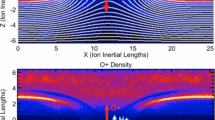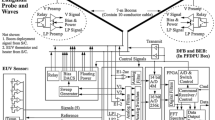Abstract
The F3C Cold Plasma Analyzer (CPA) instrument on theFreja spacecraft is designed to measure the energy per unit charge (E/Q) of ions oe electrons in the range 0<E/Q<200 V and complements the observations made by the F3H Hot Plasma Experiment. The CPA sensor, which is deployed on a boom, is an electrostatic analyzer which produces angle/energy images of particles incident on the sensor in a plane perpendicular to the boom axis. Charged particles incident normal to the CPA sensor housing axis of symmetry, which coincides with the boom axis, pass through collimators and enter a semi-spherical electrostatic analyzer which disperses particles in energy and azimuthal angle of arrival onto an imaging MCP detector thus producing images of the particle distributions in a plane perpendicular to the boom axis. Measurements are transmitted either as discrete 16×16 (angle/energy) images or as parameters related to the incident particle distribution function. Pixels in the discrete images are separated approximately equally in azimuthal angle while the 16 energy bins are separated approximately geometrically in energy. The ratio of the maximum to minimum energy imaged is programmable up to a maximum of more than a factor of ten, and the energy range itself is also under the control of the processor and can be varied by more than an order of magnitude. The density dynamic range of the sensor is increased by the introduction of an electrostatic gating system between the entrance aperture and the analyzer which can be used to duty-cycle low-energy electrons into the sensor thus keeping the count rate within appropriate levels. To reduce the effects of spacecraft induced perturbations on the lower-energy particle distributions, the sensor portion of the instrument is deployed on a 2 m long boom, perpendicular to the spacecraft spin axis. Spacecraft rotation is used to recover complete (4π) angle/energy distributions every half spin period. In addition, the sensor skin may be biased with respect to the spacecraft ground to offset effects due to spacecraft charging. Current to the skin is monitored, making the exterior of the sensor equivalent to a large cylindrical Langmuir probe. Two separate processing paths for signals from the MCP anode may be chosen; ‘slow’ and ‘rast’. The ‘slow’ pulse processing path provides discrete angle/energy images at a nominal rate of 10 images per second and a peak ‘burst mode’ rate of 100 images per second. The ‘fast’ analog or current mode path provides crude parameterized estimates of densities, temperatures and drift velocities at nominal rates of up to 1000 parameters per second with a burst rate near 6000 parameters per second. Observations of cold ions and electrons in an unperturbed ionospheric plasma are presented which demonstrate the functionality of the instrument. Suprathermal ion observations in a transverse ion energization or acceleration region are also shown which demonstrate many of the small-scale features of these events.
Similar content being viewed by others
References
Abe, T., Oyama, K., Watanabe, S., and Fukunishi, H.: 1993a, ‘Characteristic Features of Electron Temperature and Density Variations in Field-Aligned Current Regions’,J. Geophys. Res. 98, 11257–11266.
Abe, T., Whalen, B. A., Yau, A. W., Horita, R. E., Watanabe, S., and Sagawa, E.: 1993b, ‘EXOS-D (Akebono) SMS Observations of the Polar Wind’,J. Geophys. Res. 98, 11191–11203.
Arnoldy, R. L., Lynch, K. A., Kintner, P. M., Vago, J., Chesney, S., Moore, T. E., and Pollock, C. J.: 1992, ‘Bursts of Transverse Ion Acceleration at Rocket Altitudes’,Geophys. Res. Letters 19, 413.
Bingham, R., Bryant, D. A., and Hall, D. S.: 1984, ‘A Wave Model for the Aurora’,Geophys. Res. Letters 11, 327.
Block, L. P.: 1972, ‘Potential Double Layers in the Ionosphere’,Cosmic Electrodyn. 3, 349.
Bostrom, R., Gustafsson, G., Holback, B., Holmgren, G., Koskinen, H., and Kintner, P.: 1988, ‘Characteristics of Solitary Waves and Weak Double Layers in the Magnetospheric Plasma’,Phys. Rev. Letters 61, 82.
Chappell, C. R., Moore, T. E., and Waite, J. H.: 1987, ‘The Ionosphere as a Fully Adequate Source of Plasma for the Earth's Magnetosphere’,J. Geophys. Res. 92, 5896.
Garbe, G. P., Arnoldy, R. L., Moore, T. E., Kintner, P. M., and Vago, J.: 1992, ‘Observations of Ion Heating in the Topside Auroral Ionosphere’,J. Geophys Res. 97, 1257.
Goertz, C. K. and Boswell, R. W.: 1979, ‘Magnetosphere-Ionosphere Coupling’,J. Geophys. Res. 84, 7239.
Kelley, M. C., Baker, K. D., Ulwick, C., Rino, C. L., and Baron, M. J.: 1980, ‘Simultaneous Rocket Probe Scintillation and Incoherent Scatter Radar Observations of Irregularities in the Auroral Zone Ionosphere’,Radio Sci. 15, 491.
Kellogg, P. J., Monson, S. J., and Whalen, B. A.: 1984, ‘Observations of Double-Layer-Like Structures at Rocket Altitudes’,Geophys. Res. Letters 11, 515–518.
Kintner, P. M., LaBelle, J., Scales, W., Yau, A. W., and Whalen, B. A.: 1986, ‘Observations of Plasma Waves within Regions of Perpendicular Ion Acceleration’,Geophys. Res. Letters 13, 1113.
Knudsen, D. J., Whalen, B. A., Abe, T., and yau, A. W.: 1993, ‘Temporal Evolution and Spatial Dispersion of Ion Conics’, inProceedings of Yosemite Conference on Solar System Plasma Physics: Resolution of Processes in Space and Time, submitted.
Maggs, J. E. and Davis, T. N.: 1968, ‘Measurements of the Thicknesses of Auroral Structures’,Planetary Space Sci. 16, 205.
Shelley, E. G., Sharp, R. D., and Johnson, R. G.: 1976, ‘Satellite Observations of an Ionospheric Acceleration Mechanism’,Geophys. Res. Letters 3, 654.
Watanabe, S., Whalen, B. A., and Yau, A. W.: 1992, ‘Thermal Ion Observations During Plasmasphere Depletion and Refilling’,J. Geophys. Res. 97, 1081–1096.
Whalen, B. A., Bernstein, W., and Daly, P. W.: 1978, ‘Low Altitude Acceleration of Ionospheric Ions’,Geophys. Res. Letters. 5, 55.
Whalen, B. A., Watanabe, S., and Yau, A. W.: 1991, ‘Observations in the Transverse Ion Energization Region’,Geophys. Res. Letters 18, 725–728.
Yau, A. W., Whalen, B. A., McNamara, A. G., Kellogg, P. J., and Bernstein, W.: 1983, ‘Particle and Wave Observations of Low-Altitude Ionospheric Ion Acceleration Events’,J. Geophys. Res. 88, 341–355.
Author information
Authors and Affiliations
Additional information
The Canadian Government's right to retain a non-exclusive, royalty free licence in and to any copyright is acknowledge.
Rights and permissions
About this article
Cite this article
Whalen, B.A., Knudsen, D.J., Yau, A.W. et al. The Freja F3C Cold Plasma Analyzer. Space Sci Rev 70, 541–561 (1994). https://doi.org/10.1007/BF00756885
Received:
Issue Date:
DOI: https://doi.org/10.1007/BF00756885




